System Analysis and Design 11: Headspace Project Cloud Solution Report
VerifiedAdded on 2020/03/23
|12
|2693
|215
Report
AI Summary
This report provides a comprehensive analysis of system analysis and design, focusing on the Headspace project and its requirements for a cloud-based solution. It begins with an introduction to virtualization and cloud computing, highlighting their importance in meeting the demands of modern systems. The report then delves into non-functional requirements, system qualities, and user interface considerations. It explores system constraints, including technical and business drawbacks, and evaluates the pros and cons of cloud-based solutions for the Headspace project. Furthermore, the report examines the System Development Life Cycle (SDLC), comparing predictive and adaptive approaches and recommending the adaptive method for the project. The conclusion emphasizes the need for an agile system and the significance of cloud computing and security features for the Headspace project. References are provided to support the analysis.

SYSTEM ANALYSIS AND DESIGN 1
Assignment
[Student Name Here]
[Institution’s Name Here]
[Professor’s Name Here]
[Date Here]
Assignment
[Student Name Here]
[Institution’s Name Here]
[Professor’s Name Here]
[Date Here]
Paraphrase This Document
Need a fresh take? Get an instant paraphrase of this document with our AI Paraphraser
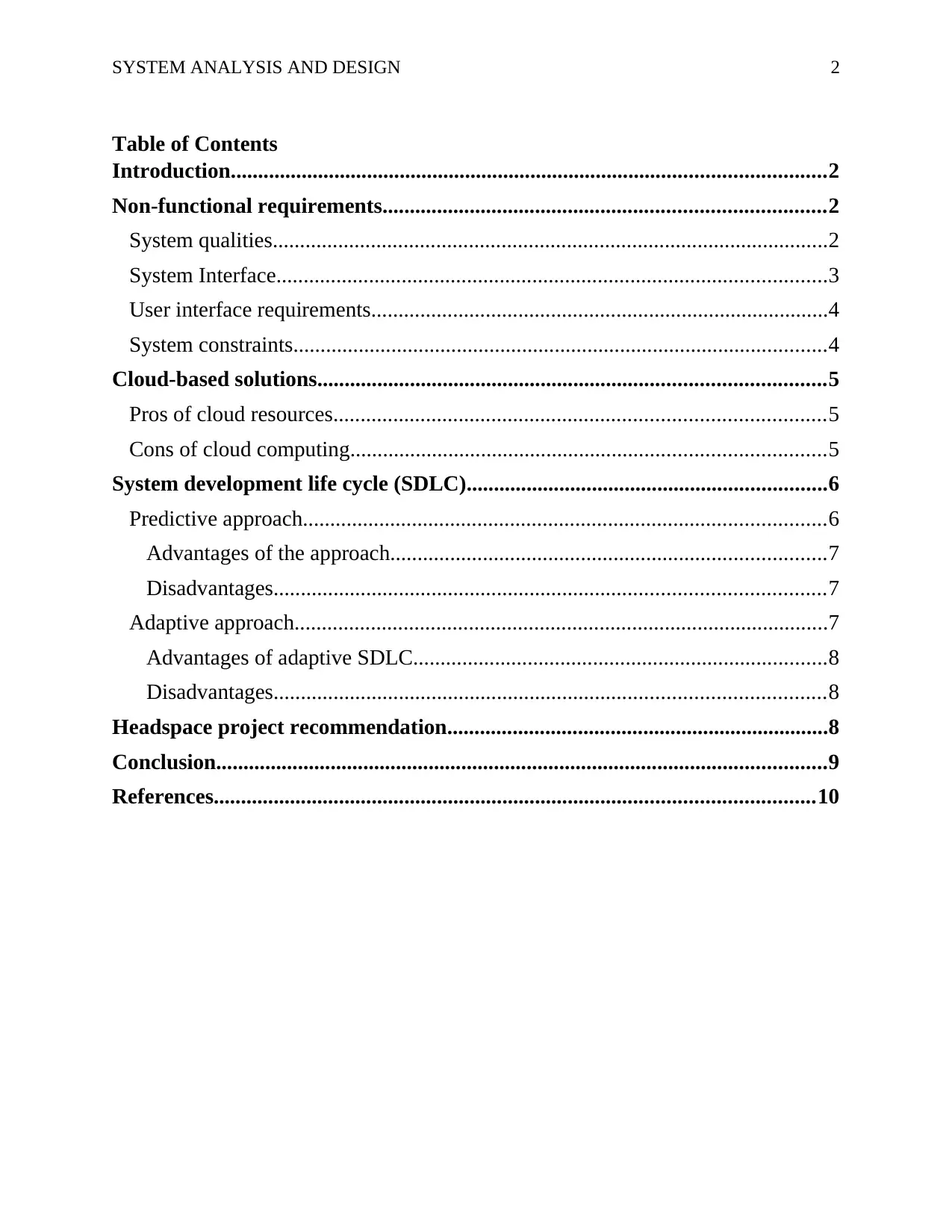
SYSTEM ANALYSIS AND DESIGN 2
Table of Contents
Introduction.............................................................................................................2
Non-functional requirements.................................................................................2
System qualities......................................................................................................2
System Interface.....................................................................................................3
User interface requirements....................................................................................4
System constraints..................................................................................................4
Cloud-based solutions.............................................................................................5
Pros of cloud resources..........................................................................................5
Cons of cloud computing.......................................................................................5
System development life cycle (SDLC)..................................................................6
Predictive approach................................................................................................6
Advantages of the approach................................................................................7
Disadvantages.....................................................................................................7
Adaptive approach..................................................................................................7
Advantages of adaptive SDLC............................................................................8
Disadvantages.....................................................................................................8
Headspace project recommendation......................................................................8
Conclusion................................................................................................................9
References..............................................................................................................10
Table of Contents
Introduction.............................................................................................................2
Non-functional requirements.................................................................................2
System qualities......................................................................................................2
System Interface.....................................................................................................3
User interface requirements....................................................................................4
System constraints..................................................................................................4
Cloud-based solutions.............................................................................................5
Pros of cloud resources..........................................................................................5
Cons of cloud computing.......................................................................................5
System development life cycle (SDLC)..................................................................6
Predictive approach................................................................................................6
Advantages of the approach................................................................................7
Disadvantages.....................................................................................................7
Adaptive approach..................................................................................................7
Advantages of adaptive SDLC............................................................................8
Disadvantages.....................................................................................................8
Headspace project recommendation......................................................................8
Conclusion................................................................................................................9
References..............................................................................................................10
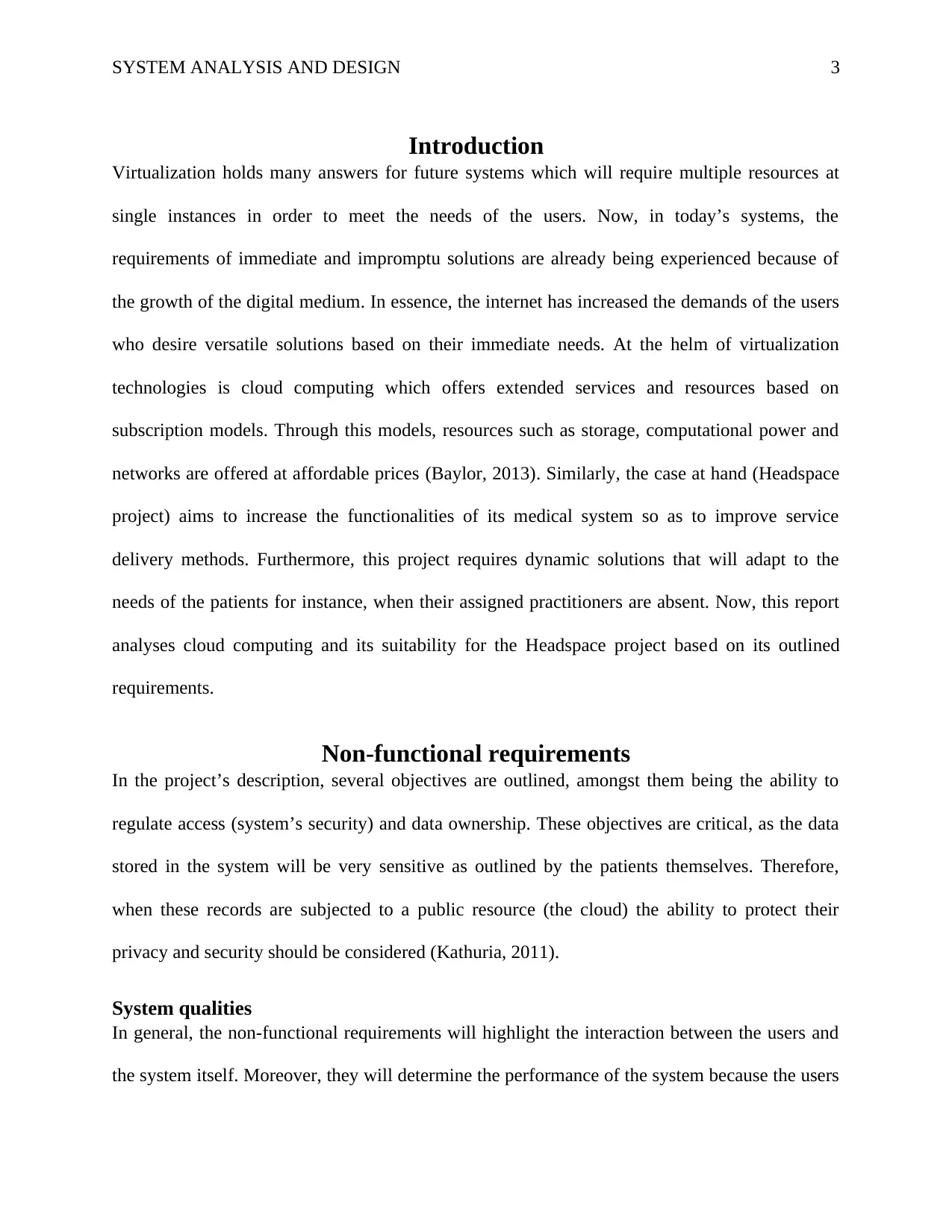
SYSTEM ANALYSIS AND DESIGN 3
Introduction
Virtualization holds many answers for future systems which will require multiple resources at
single instances in order to meet the needs of the users. Now, in today’s systems, the
requirements of immediate and impromptu solutions are already being experienced because of
the growth of the digital medium. In essence, the internet has increased the demands of the users
who desire versatile solutions based on their immediate needs. At the helm of virtualization
technologies is cloud computing which offers extended services and resources based on
subscription models. Through this models, resources such as storage, computational power and
networks are offered at affordable prices (Baylor, 2013). Similarly, the case at hand (Headspace
project) aims to increase the functionalities of its medical system so as to improve service
delivery methods. Furthermore, this project requires dynamic solutions that will adapt to the
needs of the patients for instance, when their assigned practitioners are absent. Now, this report
analyses cloud computing and its suitability for the Headspace project based on its outlined
requirements.
Non-functional requirements
In the project’s description, several objectives are outlined, amongst them being the ability to
regulate access (system’s security) and data ownership. These objectives are critical, as the data
stored in the system will be very sensitive as outlined by the patients themselves. Therefore,
when these records are subjected to a public resource (the cloud) the ability to protect their
privacy and security should be considered (Kathuria, 2011).
System qualities
In general, the non-functional requirements will highlight the interaction between the users and
the system itself. Moreover, they will determine the performance of the system because the users
Introduction
Virtualization holds many answers for future systems which will require multiple resources at
single instances in order to meet the needs of the users. Now, in today’s systems, the
requirements of immediate and impromptu solutions are already being experienced because of
the growth of the digital medium. In essence, the internet has increased the demands of the users
who desire versatile solutions based on their immediate needs. At the helm of virtualization
technologies is cloud computing which offers extended services and resources based on
subscription models. Through this models, resources such as storage, computational power and
networks are offered at affordable prices (Baylor, 2013). Similarly, the case at hand (Headspace
project) aims to increase the functionalities of its medical system so as to improve service
delivery methods. Furthermore, this project requires dynamic solutions that will adapt to the
needs of the patients for instance, when their assigned practitioners are absent. Now, this report
analyses cloud computing and its suitability for the Headspace project based on its outlined
requirements.
Non-functional requirements
In the project’s description, several objectives are outlined, amongst them being the ability to
regulate access (system’s security) and data ownership. These objectives are critical, as the data
stored in the system will be very sensitive as outlined by the patients themselves. Therefore,
when these records are subjected to a public resource (the cloud) the ability to protect their
privacy and security should be considered (Kathuria, 2011).
System qualities
In general, the non-functional requirements will highlight the interaction between the users and
the system itself. Moreover, they will determine the performance of the system because the users
⊘ This is a preview!⊘
Do you want full access?
Subscribe today to unlock all pages.

Trusted by 1+ million students worldwide
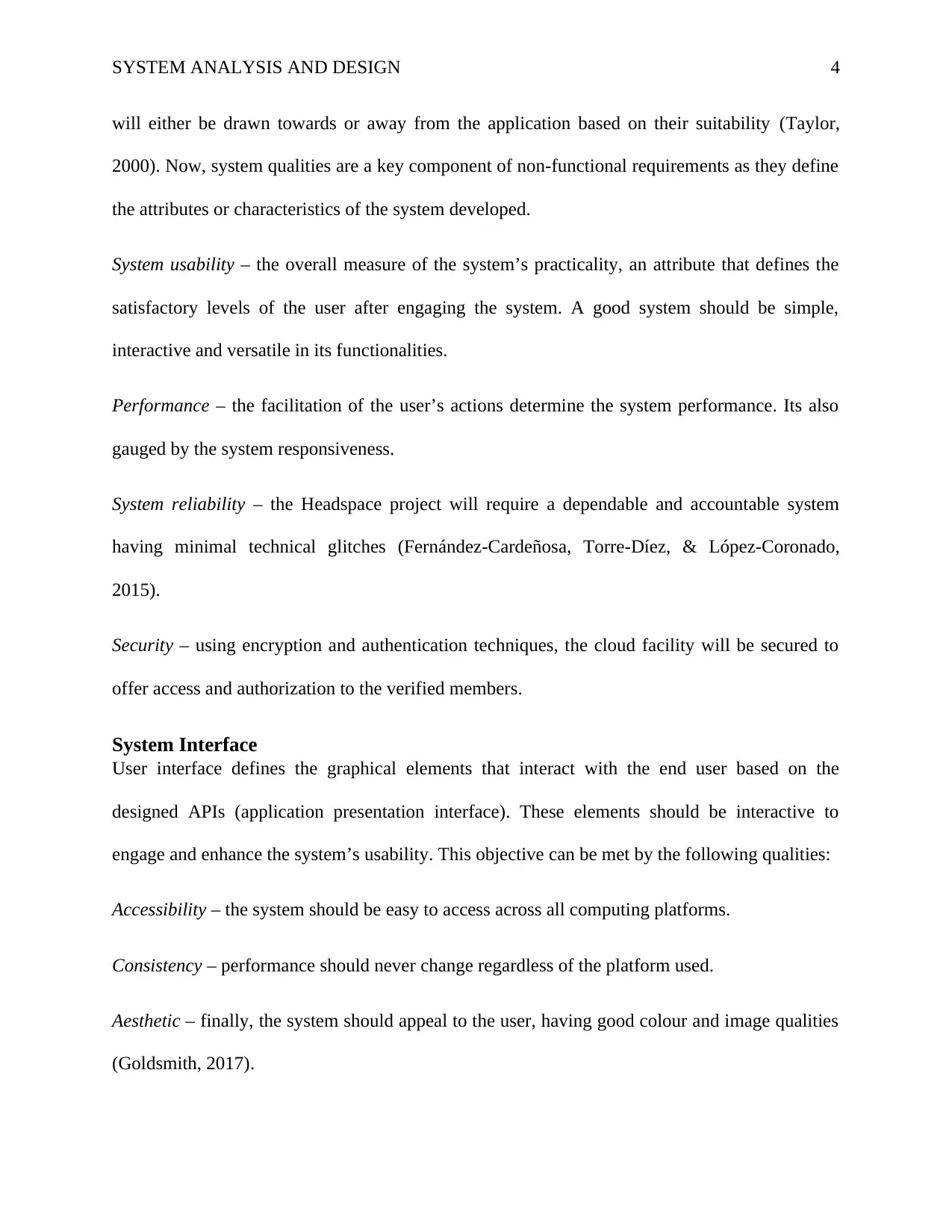
SYSTEM ANALYSIS AND DESIGN 4
will either be drawn towards or away from the application based on their suitability (Taylor,
2000). Now, system qualities are a key component of non-functional requirements as they define
the attributes or characteristics of the system developed.
System usability – the overall measure of the system’s practicality, an attribute that defines the
satisfactory levels of the user after engaging the system. A good system should be simple,
interactive and versatile in its functionalities.
Performance – the facilitation of the user’s actions determine the system performance. Its also
gauged by the system responsiveness.
System reliability – the Headspace project will require a dependable and accountable system
having minimal technical glitches (Fernández-Cardeñosa, Torre-Díez, & López-Coronado,
2015).
Security – using encryption and authentication techniques, the cloud facility will be secured to
offer access and authorization to the verified members.
System Interface
User interface defines the graphical elements that interact with the end user based on the
designed APIs (application presentation interface). These elements should be interactive to
engage and enhance the system’s usability. This objective can be met by the following qualities:
Accessibility – the system should be easy to access across all computing platforms.
Consistency – performance should never change regardless of the platform used.
Aesthetic – finally, the system should appeal to the user, having good colour and image qualities
(Goldsmith, 2017).
will either be drawn towards or away from the application based on their suitability (Taylor,
2000). Now, system qualities are a key component of non-functional requirements as they define
the attributes or characteristics of the system developed.
System usability – the overall measure of the system’s practicality, an attribute that defines the
satisfactory levels of the user after engaging the system. A good system should be simple,
interactive and versatile in its functionalities.
Performance – the facilitation of the user’s actions determine the system performance. Its also
gauged by the system responsiveness.
System reliability – the Headspace project will require a dependable and accountable system
having minimal technical glitches (Fernández-Cardeñosa, Torre-Díez, & López-Coronado,
2015).
Security – using encryption and authentication techniques, the cloud facility will be secured to
offer access and authorization to the verified members.
System Interface
User interface defines the graphical elements that interact with the end user based on the
designed APIs (application presentation interface). These elements should be interactive to
engage and enhance the system’s usability. This objective can be met by the following qualities:
Accessibility – the system should be easy to access across all computing platforms.
Consistency – performance should never change regardless of the platform used.
Aesthetic – finally, the system should appeal to the user, having good colour and image qualities
(Goldsmith, 2017).
Paraphrase This Document
Need a fresh take? Get an instant paraphrase of this document with our AI Paraphraser
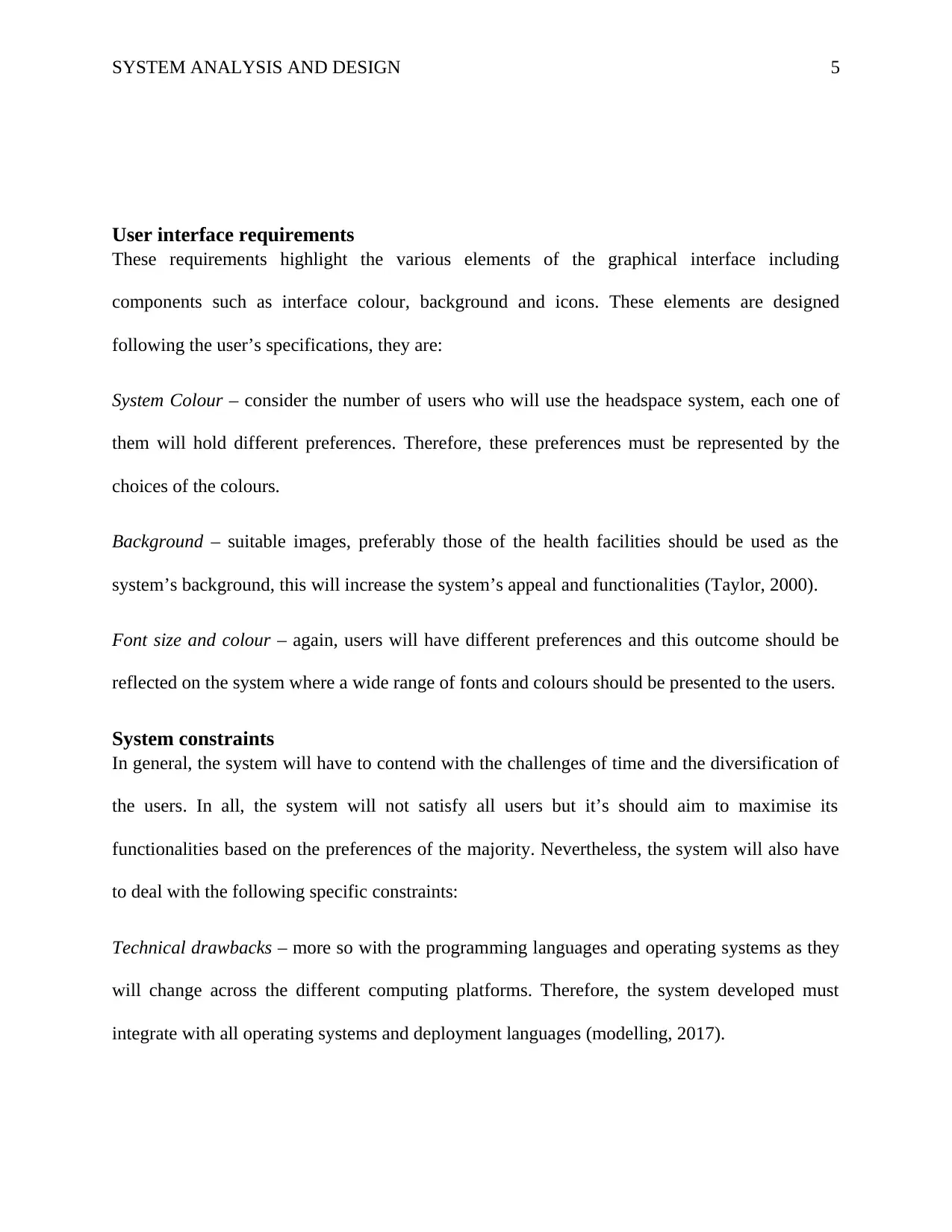
SYSTEM ANALYSIS AND DESIGN 5
User interface requirements
These requirements highlight the various elements of the graphical interface including
components such as interface colour, background and icons. These elements are designed
following the user’s specifications, they are:
System Colour – consider the number of users who will use the headspace system, each one of
them will hold different preferences. Therefore, these preferences must be represented by the
choices of the colours.
Background – suitable images, preferably those of the health facilities should be used as the
system’s background, this will increase the system’s appeal and functionalities (Taylor, 2000).
Font size and colour – again, users will have different preferences and this outcome should be
reflected on the system where a wide range of fonts and colours should be presented to the users.
System constraints
In general, the system will have to contend with the challenges of time and the diversification of
the users. In all, the system will not satisfy all users but it’s should aim to maximise its
functionalities based on the preferences of the majority. Nevertheless, the system will also have
to deal with the following specific constraints:
Technical drawbacks – more so with the programming languages and operating systems as they
will change across the different computing platforms. Therefore, the system developed must
integrate with all operating systems and deployment languages (modelling, 2017).
User interface requirements
These requirements highlight the various elements of the graphical interface including
components such as interface colour, background and icons. These elements are designed
following the user’s specifications, they are:
System Colour – consider the number of users who will use the headspace system, each one of
them will hold different preferences. Therefore, these preferences must be represented by the
choices of the colours.
Background – suitable images, preferably those of the health facilities should be used as the
system’s background, this will increase the system’s appeal and functionalities (Taylor, 2000).
Font size and colour – again, users will have different preferences and this outcome should be
reflected on the system where a wide range of fonts and colours should be presented to the users.
System constraints
In general, the system will have to contend with the challenges of time and the diversification of
the users. In all, the system will not satisfy all users but it’s should aim to maximise its
functionalities based on the preferences of the majority. Nevertheless, the system will also have
to deal with the following specific constraints:
Technical drawbacks – more so with the programming languages and operating systems as they
will change across the different computing platforms. Therefore, the system developed must
integrate with all operating systems and deployment languages (modelling, 2017).
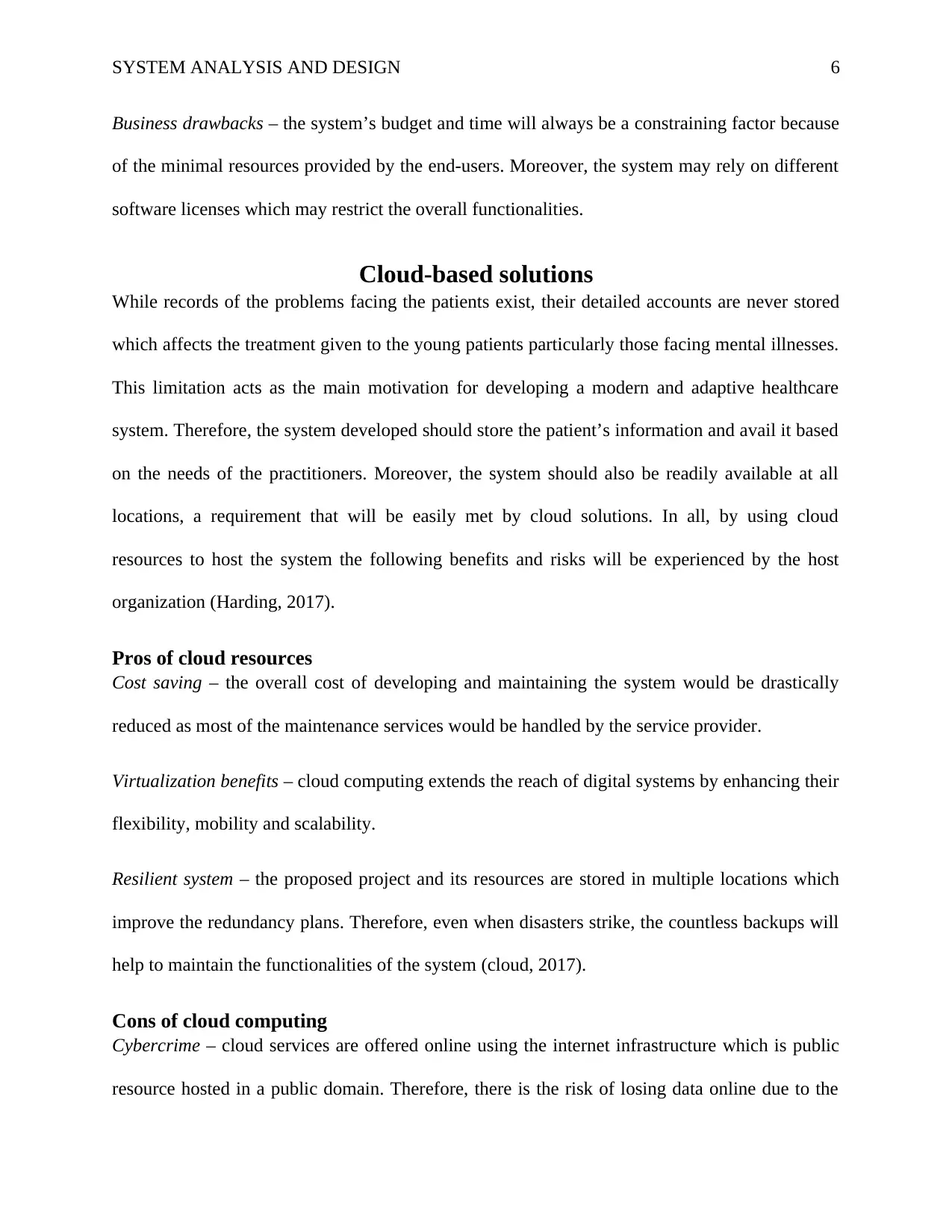
SYSTEM ANALYSIS AND DESIGN 6
Business drawbacks – the system’s budget and time will always be a constraining factor because
of the minimal resources provided by the end-users. Moreover, the system may rely on different
software licenses which may restrict the overall functionalities.
Cloud-based solutions
While records of the problems facing the patients exist, their detailed accounts are never stored
which affects the treatment given to the young patients particularly those facing mental illnesses.
This limitation acts as the main motivation for developing a modern and adaptive healthcare
system. Therefore, the system developed should store the patient’s information and avail it based
on the needs of the practitioners. Moreover, the system should also be readily available at all
locations, a requirement that will be easily met by cloud solutions. In all, by using cloud
resources to host the system the following benefits and risks will be experienced by the host
organization (Harding, 2017).
Pros of cloud resources
Cost saving – the overall cost of developing and maintaining the system would be drastically
reduced as most of the maintenance services would be handled by the service provider.
Virtualization benefits – cloud computing extends the reach of digital systems by enhancing their
flexibility, mobility and scalability.
Resilient system – the proposed project and its resources are stored in multiple locations which
improve the redundancy plans. Therefore, even when disasters strike, the countless backups will
help to maintain the functionalities of the system (cloud, 2017).
Cons of cloud computing
Cybercrime – cloud services are offered online using the internet infrastructure which is public
resource hosted in a public domain. Therefore, there is the risk of losing data online due to the
Business drawbacks – the system’s budget and time will always be a constraining factor because
of the minimal resources provided by the end-users. Moreover, the system may rely on different
software licenses which may restrict the overall functionalities.
Cloud-based solutions
While records of the problems facing the patients exist, their detailed accounts are never stored
which affects the treatment given to the young patients particularly those facing mental illnesses.
This limitation acts as the main motivation for developing a modern and adaptive healthcare
system. Therefore, the system developed should store the patient’s information and avail it based
on the needs of the practitioners. Moreover, the system should also be readily available at all
locations, a requirement that will be easily met by cloud solutions. In all, by using cloud
resources to host the system the following benefits and risks will be experienced by the host
organization (Harding, 2017).
Pros of cloud resources
Cost saving – the overall cost of developing and maintaining the system would be drastically
reduced as most of the maintenance services would be handled by the service provider.
Virtualization benefits – cloud computing extends the reach of digital systems by enhancing their
flexibility, mobility and scalability.
Resilient system – the proposed project and its resources are stored in multiple locations which
improve the redundancy plans. Therefore, even when disasters strike, the countless backups will
help to maintain the functionalities of the system (cloud, 2017).
Cons of cloud computing
Cybercrime – cloud services are offered online using the internet infrastructure which is public
resource hosted in a public domain. Therefore, there is the risk of losing data online due to the
⊘ This is a preview!⊘
Do you want full access?
Subscribe today to unlock all pages.

Trusted by 1+ million students worldwide
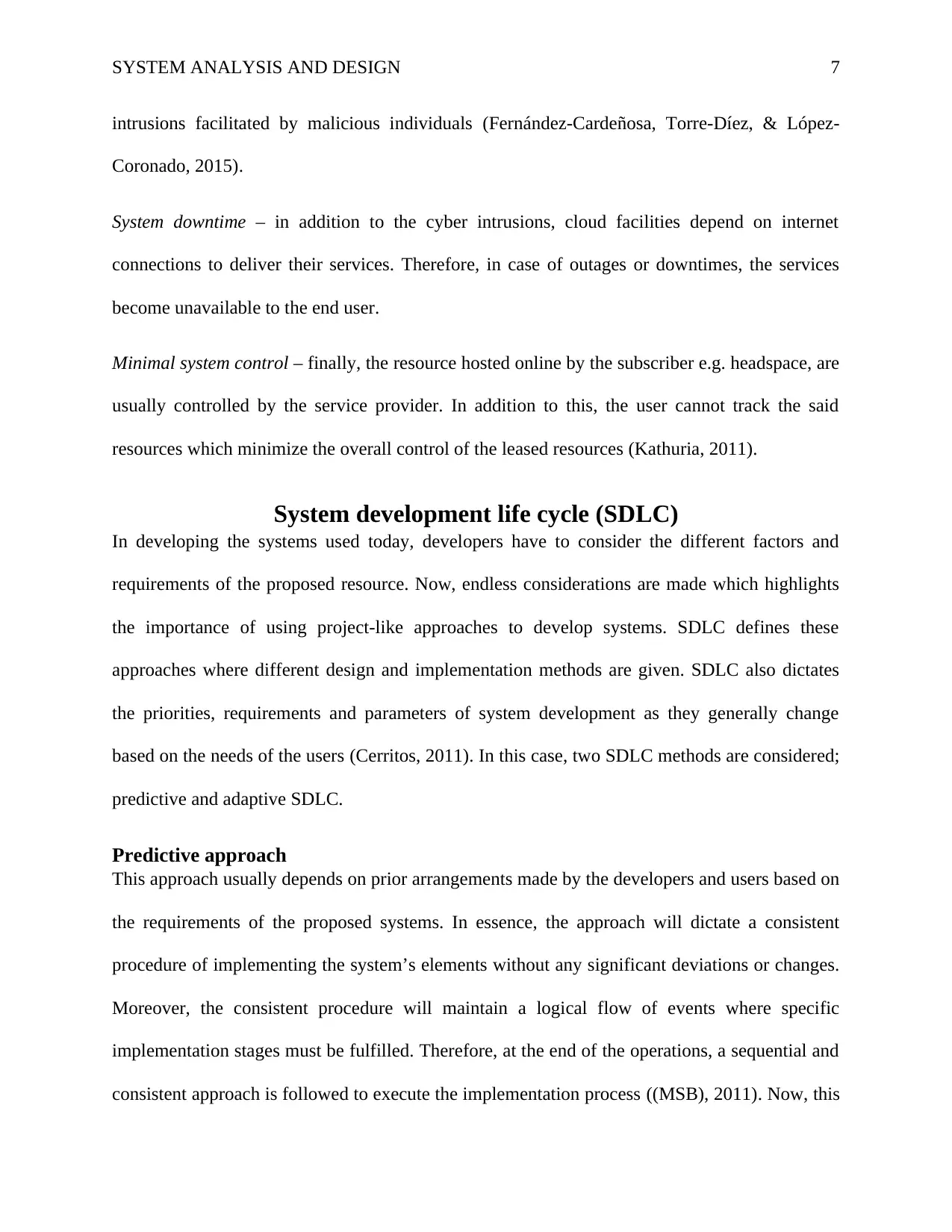
SYSTEM ANALYSIS AND DESIGN 7
intrusions facilitated by malicious individuals (Fernández-Cardeñosa, Torre-Díez, & López-
Coronado, 2015).
System downtime – in addition to the cyber intrusions, cloud facilities depend on internet
connections to deliver their services. Therefore, in case of outages or downtimes, the services
become unavailable to the end user.
Minimal system control – finally, the resource hosted online by the subscriber e.g. headspace, are
usually controlled by the service provider. In addition to this, the user cannot track the said
resources which minimize the overall control of the leased resources (Kathuria, 2011).
System development life cycle (SDLC)
In developing the systems used today, developers have to consider the different factors and
requirements of the proposed resource. Now, endless considerations are made which highlights
the importance of using project-like approaches to develop systems. SDLC defines these
approaches where different design and implementation methods are given. SDLC also dictates
the priorities, requirements and parameters of system development as they generally change
based on the needs of the users (Cerritos, 2011). In this case, two SDLC methods are considered;
predictive and adaptive SDLC.
Predictive approach
This approach usually depends on prior arrangements made by the developers and users based on
the requirements of the proposed systems. In essence, the approach will dictate a consistent
procedure of implementing the system’s elements without any significant deviations or changes.
Moreover, the consistent procedure will maintain a logical flow of events where specific
implementation stages must be fulfilled. Therefore, at the end of the operations, a sequential and
consistent approach is followed to execute the implementation process ((MSB), 2011). Now, this
intrusions facilitated by malicious individuals (Fernández-Cardeñosa, Torre-Díez, & López-
Coronado, 2015).
System downtime – in addition to the cyber intrusions, cloud facilities depend on internet
connections to deliver their services. Therefore, in case of outages or downtimes, the services
become unavailable to the end user.
Minimal system control – finally, the resource hosted online by the subscriber e.g. headspace, are
usually controlled by the service provider. In addition to this, the user cannot track the said
resources which minimize the overall control of the leased resources (Kathuria, 2011).
System development life cycle (SDLC)
In developing the systems used today, developers have to consider the different factors and
requirements of the proposed resource. Now, endless considerations are made which highlights
the importance of using project-like approaches to develop systems. SDLC defines these
approaches where different design and implementation methods are given. SDLC also dictates
the priorities, requirements and parameters of system development as they generally change
based on the needs of the users (Cerritos, 2011). In this case, two SDLC methods are considered;
predictive and adaptive SDLC.
Predictive approach
This approach usually depends on prior arrangements made by the developers and users based on
the requirements of the proposed systems. In essence, the approach will dictate a consistent
procedure of implementing the system’s elements without any significant deviations or changes.
Moreover, the consistent procedure will maintain a logical flow of events where specific
implementation stages must be fulfilled. Therefore, at the end of the operations, a sequential and
consistent approach is followed to execute the implementation process ((MSB), 2011). Now, this
Paraphrase This Document
Need a fresh take? Get an instant paraphrase of this document with our AI Paraphraser
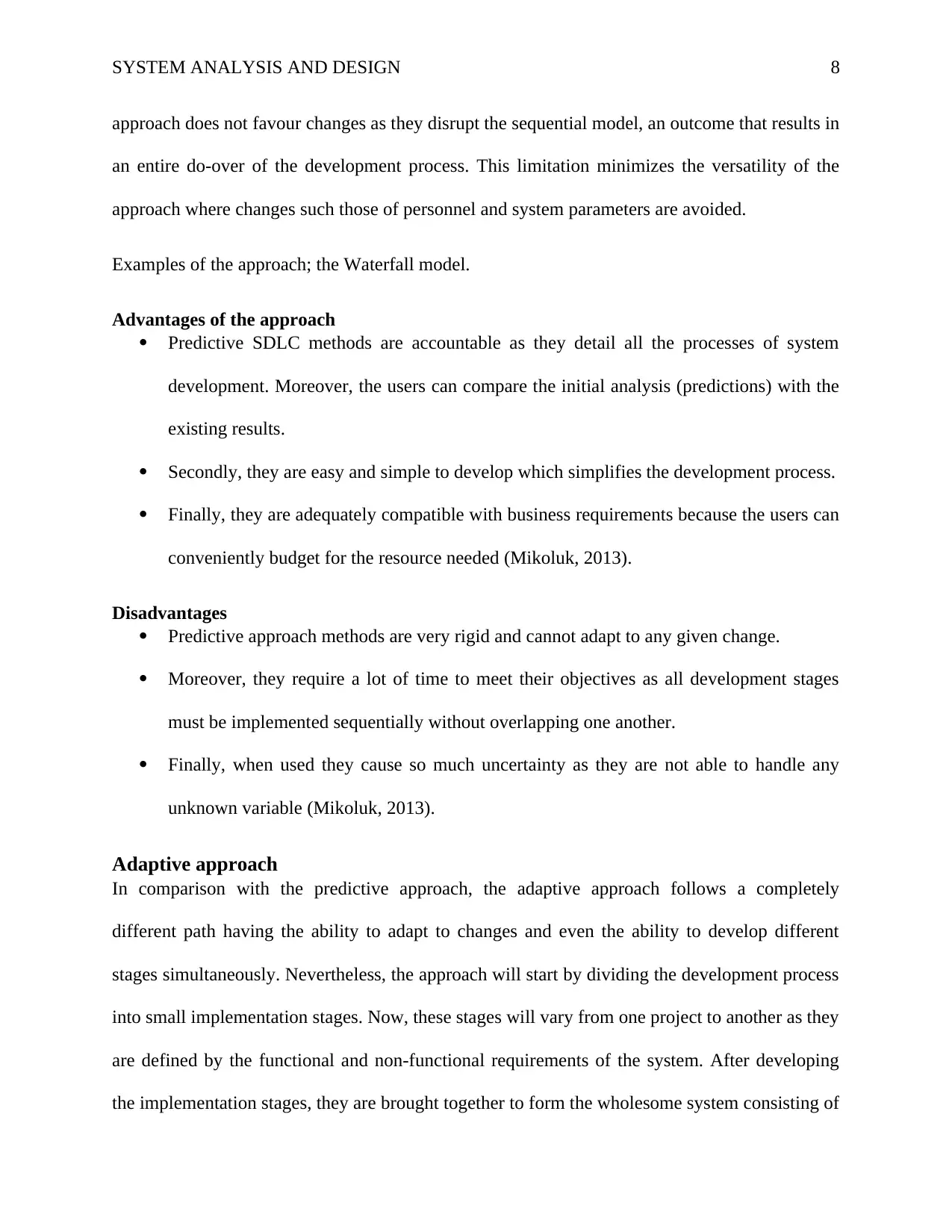
SYSTEM ANALYSIS AND DESIGN 8
approach does not favour changes as they disrupt the sequential model, an outcome that results in
an entire do-over of the development process. This limitation minimizes the versatility of the
approach where changes such those of personnel and system parameters are avoided.
Examples of the approach; the Waterfall model.
Advantages of the approach
Predictive SDLC methods are accountable as they detail all the processes of system
development. Moreover, the users can compare the initial analysis (predictions) with the
existing results.
Secondly, they are easy and simple to develop which simplifies the development process.
Finally, they are adequately compatible with business requirements because the users can
conveniently budget for the resource needed (Mikoluk, 2013).
Disadvantages
Predictive approach methods are very rigid and cannot adapt to any given change.
Moreover, they require a lot of time to meet their objectives as all development stages
must be implemented sequentially without overlapping one another.
Finally, when used they cause so much uncertainty as they are not able to handle any
unknown variable (Mikoluk, 2013).
Adaptive approach
In comparison with the predictive approach, the adaptive approach follows a completely
different path having the ability to adapt to changes and even the ability to develop different
stages simultaneously. Nevertheless, the approach will start by dividing the development process
into small implementation stages. Now, these stages will vary from one project to another as they
are defined by the functional and non-functional requirements of the system. After developing
the implementation stages, they are brought together to form the wholesome system consisting of
approach does not favour changes as they disrupt the sequential model, an outcome that results in
an entire do-over of the development process. This limitation minimizes the versatility of the
approach where changes such those of personnel and system parameters are avoided.
Examples of the approach; the Waterfall model.
Advantages of the approach
Predictive SDLC methods are accountable as they detail all the processes of system
development. Moreover, the users can compare the initial analysis (predictions) with the
existing results.
Secondly, they are easy and simple to develop which simplifies the development process.
Finally, they are adequately compatible with business requirements because the users can
conveniently budget for the resource needed (Mikoluk, 2013).
Disadvantages
Predictive approach methods are very rigid and cannot adapt to any given change.
Moreover, they require a lot of time to meet their objectives as all development stages
must be implemented sequentially without overlapping one another.
Finally, when used they cause so much uncertainty as they are not able to handle any
unknown variable (Mikoluk, 2013).
Adaptive approach
In comparison with the predictive approach, the adaptive approach follows a completely
different path having the ability to adapt to changes and even the ability to develop different
stages simultaneously. Nevertheless, the approach will start by dividing the development process
into small implementation stages. Now, these stages will vary from one project to another as they
are defined by the functional and non-functional requirements of the system. After developing
the implementation stages, they are brought together to form the wholesome system consisting of
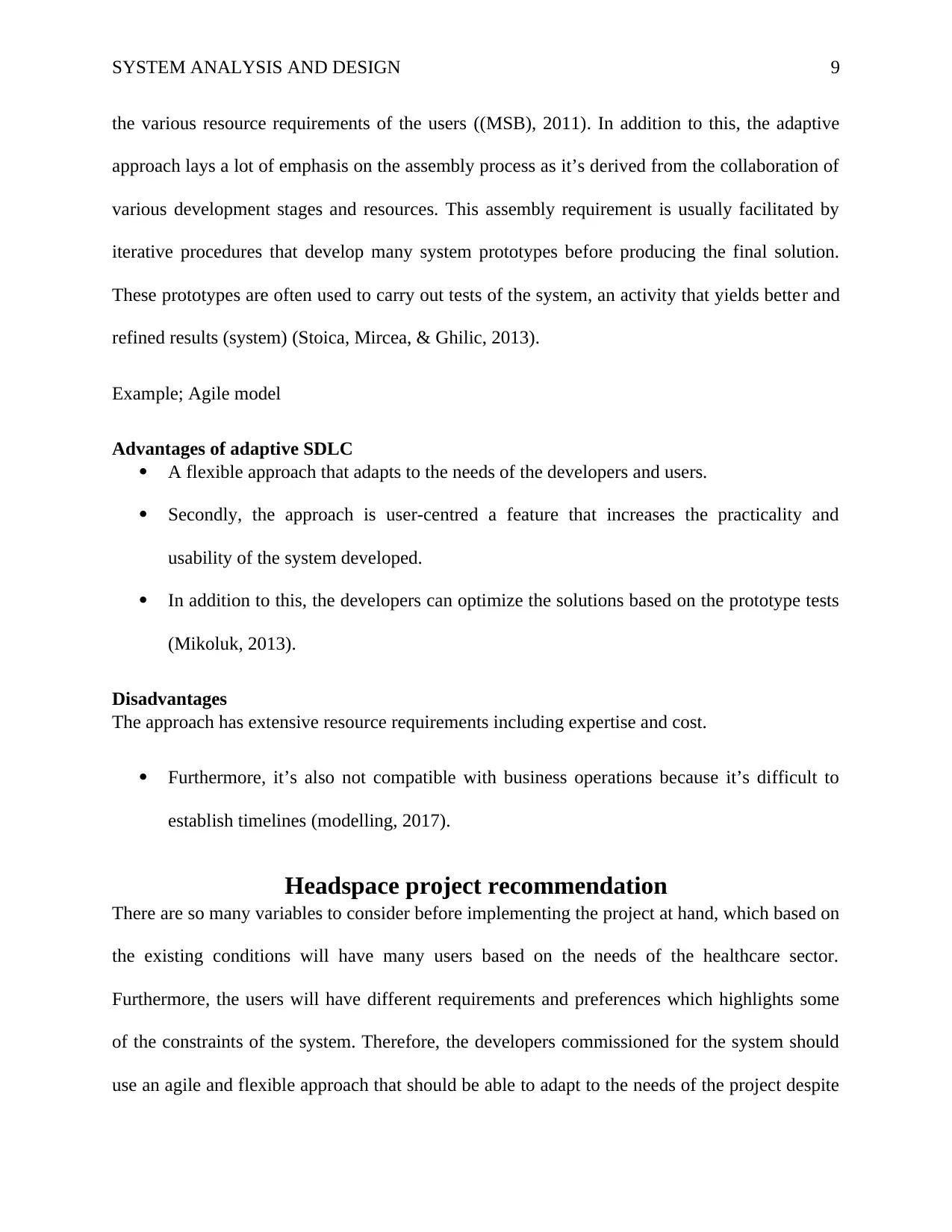
SYSTEM ANALYSIS AND DESIGN 9
the various resource requirements of the users ((MSB), 2011). In addition to this, the adaptive
approach lays a lot of emphasis on the assembly process as it’s derived from the collaboration of
various development stages and resources. This assembly requirement is usually facilitated by
iterative procedures that develop many system prototypes before producing the final solution.
These prototypes are often used to carry out tests of the system, an activity that yields better and
refined results (system) (Stoica, Mircea, & Ghilic, 2013).
Example; Agile model
Advantages of adaptive SDLC
A flexible approach that adapts to the needs of the developers and users.
Secondly, the approach is user-centred a feature that increases the practicality and
usability of the system developed.
In addition to this, the developers can optimize the solutions based on the prototype tests
(Mikoluk, 2013).
Disadvantages
The approach has extensive resource requirements including expertise and cost.
Furthermore, it’s also not compatible with business operations because it’s difficult to
establish timelines (modelling, 2017).
Headspace project recommendation
There are so many variables to consider before implementing the project at hand, which based on
the existing conditions will have many users based on the needs of the healthcare sector.
Furthermore, the users will have different requirements and preferences which highlights some
of the constraints of the system. Therefore, the developers commissioned for the system should
use an agile and flexible approach that should be able to adapt to the needs of the project despite
the various resource requirements of the users ((MSB), 2011). In addition to this, the adaptive
approach lays a lot of emphasis on the assembly process as it’s derived from the collaboration of
various development stages and resources. This assembly requirement is usually facilitated by
iterative procedures that develop many system prototypes before producing the final solution.
These prototypes are often used to carry out tests of the system, an activity that yields better and
refined results (system) (Stoica, Mircea, & Ghilic, 2013).
Example; Agile model
Advantages of adaptive SDLC
A flexible approach that adapts to the needs of the developers and users.
Secondly, the approach is user-centred a feature that increases the practicality and
usability of the system developed.
In addition to this, the developers can optimize the solutions based on the prototype tests
(Mikoluk, 2013).
Disadvantages
The approach has extensive resource requirements including expertise and cost.
Furthermore, it’s also not compatible with business operations because it’s difficult to
establish timelines (modelling, 2017).
Headspace project recommendation
There are so many variables to consider before implementing the project at hand, which based on
the existing conditions will have many users based on the needs of the healthcare sector.
Furthermore, the users will have different requirements and preferences which highlights some
of the constraints of the system. Therefore, the developers commissioned for the system should
use an agile and flexible approach that should be able to adapt to the needs of the project despite
⊘ This is a preview!⊘
Do you want full access?
Subscribe today to unlock all pages.

Trusted by 1+ million students worldwide
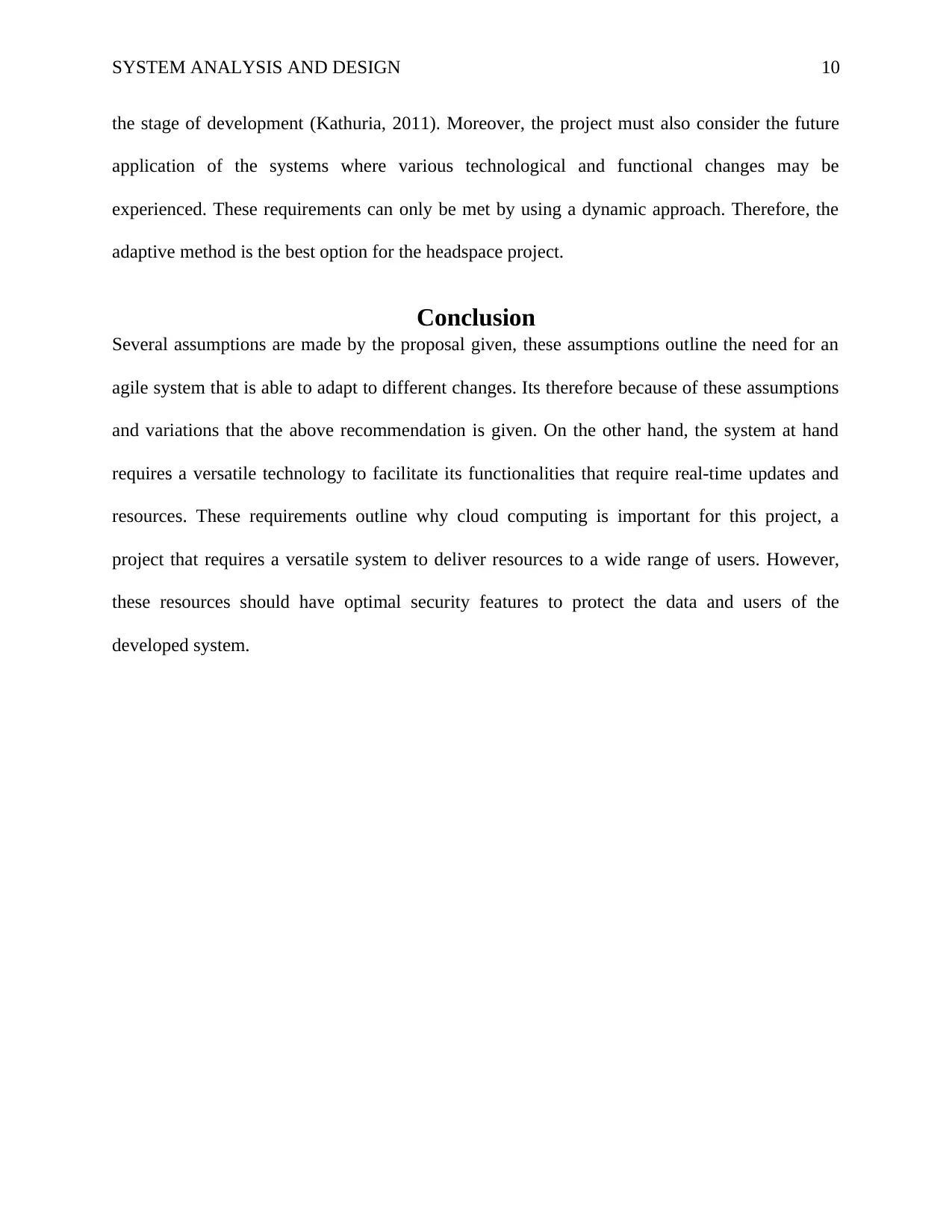
SYSTEM ANALYSIS AND DESIGN 10
the stage of development (Kathuria, 2011). Moreover, the project must also consider the future
application of the systems where various technological and functional changes may be
experienced. These requirements can only be met by using a dynamic approach. Therefore, the
adaptive method is the best option for the headspace project.
Conclusion
Several assumptions are made by the proposal given, these assumptions outline the need for an
agile system that is able to adapt to different changes. Its therefore because of these assumptions
and variations that the above recommendation is given. On the other hand, the system at hand
requires a versatile technology to facilitate its functionalities that require real-time updates and
resources. These requirements outline why cloud computing is important for this project, a
project that requires a versatile system to deliver resources to a wide range of users. However,
these resources should have optimal security features to protect the data and users of the
developed system.
the stage of development (Kathuria, 2011). Moreover, the project must also consider the future
application of the systems where various technological and functional changes may be
experienced. These requirements can only be met by using a dynamic approach. Therefore, the
adaptive method is the best option for the headspace project.
Conclusion
Several assumptions are made by the proposal given, these assumptions outline the need for an
agile system that is able to adapt to different changes. Its therefore because of these assumptions
and variations that the above recommendation is given. On the other hand, the system at hand
requires a versatile technology to facilitate its functionalities that require real-time updates and
resources. These requirements outline why cloud computing is important for this project, a
project that requires a versatile system to deliver resources to a wide range of users. However,
these resources should have optimal security features to protect the data and users of the
developed system.
Paraphrase This Document
Need a fresh take? Get an instant paraphrase of this document with our AI Paraphraser
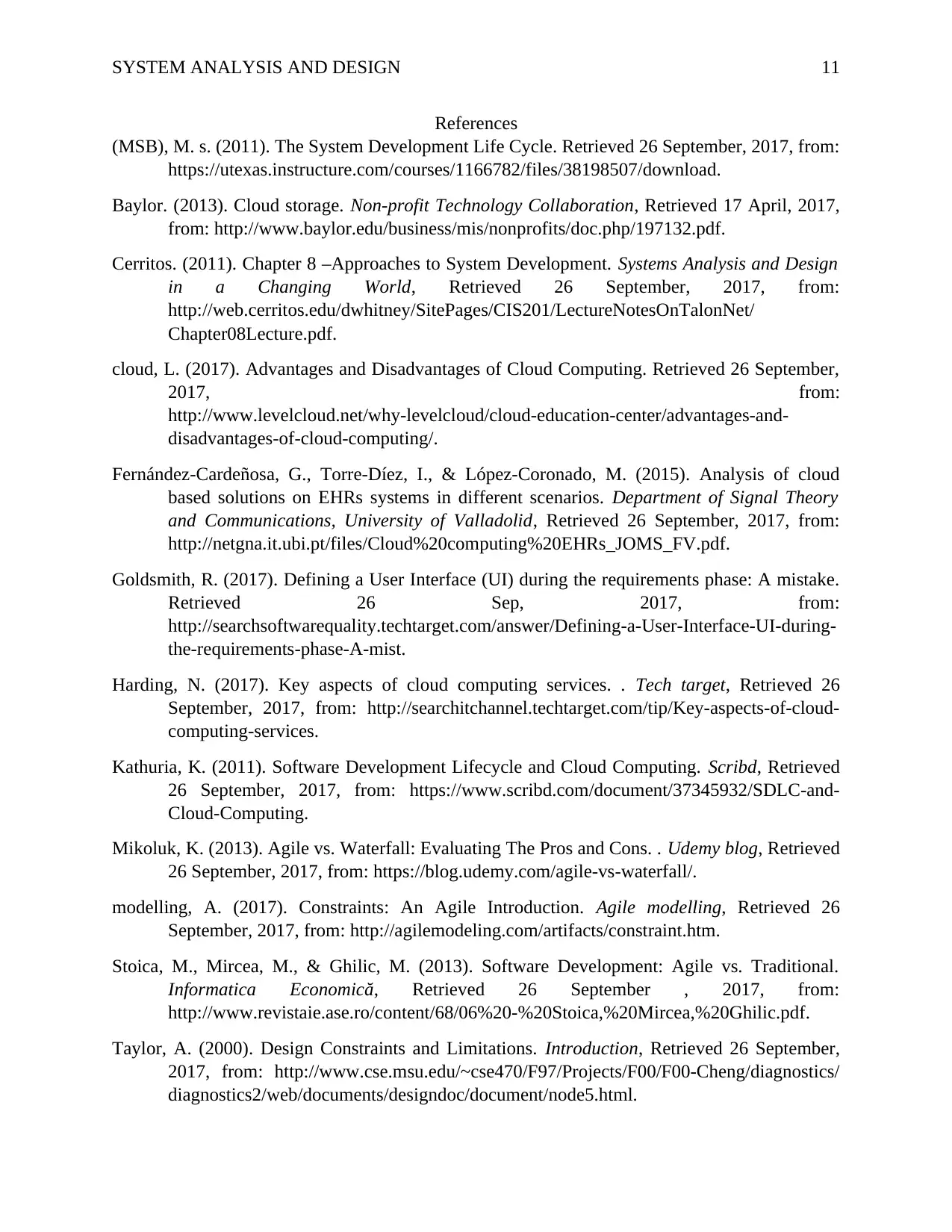
SYSTEM ANALYSIS AND DESIGN 11
References
(MSB), M. s. (2011). The System Development Life Cycle. Retrieved 26 September, 2017, from:
https://utexas.instructure.com/courses/1166782/files/38198507/download.
Baylor. (2013). Cloud storage. Non-profit Technology Collaboration, Retrieved 17 April, 2017,
from: http://www.baylor.edu/business/mis/nonprofits/doc.php/197132.pdf.
Cerritos. (2011). Chapter 8 –Approaches to System Development. Systems Analysis and Design
in a Changing World, Retrieved 26 September, 2017, from:
http://web.cerritos.edu/dwhitney/SitePages/CIS201/LectureNotesOnTalonNet/
Chapter08Lecture.pdf.
cloud, L. (2017). Advantages and Disadvantages of Cloud Computing. Retrieved 26 September,
2017, from:
http://www.levelcloud.net/why-levelcloud/cloud-education-center/advantages-and-
disadvantages-of-cloud-computing/.
Fernández-Cardeñosa, G., Torre-Díez, I., & López-Coronado, M. (2015). Analysis of cloud
based solutions on EHRs systems in different scenarios. Department of Signal Theory
and Communications, University of Valladolid, Retrieved 26 September, 2017, from:
http://netgna.it.ubi.pt/files/Cloud%20computing%20EHRs_JOMS_FV.pdf.
Goldsmith, R. (2017). Defining a User Interface (UI) during the requirements phase: A mistake.
Retrieved 26 Sep, 2017, from:
http://searchsoftwarequality.techtarget.com/answer/Defining-a-User-Interface-UI-during-
the-requirements-phase-A-mist.
Harding, N. (2017). Key aspects of cloud computing services. . Tech target, Retrieved 26
September, 2017, from: http://searchitchannel.techtarget.com/tip/Key-aspects-of-cloud-
computing-services.
Kathuria, K. (2011). Software Development Lifecycle and Cloud Computing. Scribd, Retrieved
26 September, 2017, from: https://www.scribd.com/document/37345932/SDLC-and-
Cloud-Computing.
Mikoluk, K. (2013). Agile vs. Waterfall: Evaluating The Pros and Cons. . Udemy blog, Retrieved
26 September, 2017, from: https://blog.udemy.com/agile-vs-waterfall/.
modelling, A. (2017). Constraints: An Agile Introduction. Agile modelling, Retrieved 26
September, 2017, from: http://agilemodeling.com/artifacts/constraint.htm.
Stoica, M., Mircea, M., & Ghilic, M. (2013). Software Development: Agile vs. Traditional.
Informatica Economică, Retrieved 26 September , 2017, from:
http://www.revistaie.ase.ro/content/68/06%20-%20Stoica,%20Mircea,%20Ghilic.pdf.
Taylor, A. (2000). Design Constraints and Limitations. Introduction, Retrieved 26 September,
2017, from: http://www.cse.msu.edu/~cse470/F97/Projects/F00/F00-Cheng/diagnostics/
diagnostics2/web/documents/designdoc/document/node5.html.
References
(MSB), M. s. (2011). The System Development Life Cycle. Retrieved 26 September, 2017, from:
https://utexas.instructure.com/courses/1166782/files/38198507/download.
Baylor. (2013). Cloud storage. Non-profit Technology Collaboration, Retrieved 17 April, 2017,
from: http://www.baylor.edu/business/mis/nonprofits/doc.php/197132.pdf.
Cerritos. (2011). Chapter 8 –Approaches to System Development. Systems Analysis and Design
in a Changing World, Retrieved 26 September, 2017, from:
http://web.cerritos.edu/dwhitney/SitePages/CIS201/LectureNotesOnTalonNet/
Chapter08Lecture.pdf.
cloud, L. (2017). Advantages and Disadvantages of Cloud Computing. Retrieved 26 September,
2017, from:
http://www.levelcloud.net/why-levelcloud/cloud-education-center/advantages-and-
disadvantages-of-cloud-computing/.
Fernández-Cardeñosa, G., Torre-Díez, I., & López-Coronado, M. (2015). Analysis of cloud
based solutions on EHRs systems in different scenarios. Department of Signal Theory
and Communications, University of Valladolid, Retrieved 26 September, 2017, from:
http://netgna.it.ubi.pt/files/Cloud%20computing%20EHRs_JOMS_FV.pdf.
Goldsmith, R. (2017). Defining a User Interface (UI) during the requirements phase: A mistake.
Retrieved 26 Sep, 2017, from:
http://searchsoftwarequality.techtarget.com/answer/Defining-a-User-Interface-UI-during-
the-requirements-phase-A-mist.
Harding, N. (2017). Key aspects of cloud computing services. . Tech target, Retrieved 26
September, 2017, from: http://searchitchannel.techtarget.com/tip/Key-aspects-of-cloud-
computing-services.
Kathuria, K. (2011). Software Development Lifecycle and Cloud Computing. Scribd, Retrieved
26 September, 2017, from: https://www.scribd.com/document/37345932/SDLC-and-
Cloud-Computing.
Mikoluk, K. (2013). Agile vs. Waterfall: Evaluating The Pros and Cons. . Udemy blog, Retrieved
26 September, 2017, from: https://blog.udemy.com/agile-vs-waterfall/.
modelling, A. (2017). Constraints: An Agile Introduction. Agile modelling, Retrieved 26
September, 2017, from: http://agilemodeling.com/artifacts/constraint.htm.
Stoica, M., Mircea, M., & Ghilic, M. (2013). Software Development: Agile vs. Traditional.
Informatica Economică, Retrieved 26 September , 2017, from:
http://www.revistaie.ase.ro/content/68/06%20-%20Stoica,%20Mircea,%20Ghilic.pdf.
Taylor, A. (2000). Design Constraints and Limitations. Introduction, Retrieved 26 September,
2017, from: http://www.cse.msu.edu/~cse470/F97/Projects/F00/F00-Cheng/diagnostics/
diagnostics2/web/documents/designdoc/document/node5.html.

SYSTEM ANALYSIS AND DESIGN 12
⊘ This is a preview!⊘
Do you want full access?
Subscribe today to unlock all pages.

Trusted by 1+ million students worldwide
1 out of 12
Related Documents
Your All-in-One AI-Powered Toolkit for Academic Success.
+13062052269
info@desklib.com
Available 24*7 on WhatsApp / Email
![[object Object]](/_next/static/media/star-bottom.7253800d.svg)
Unlock your academic potential
Copyright © 2020–2025 A2Z Services. All Rights Reserved. Developed and managed by ZUCOL.





